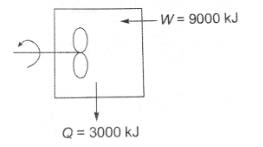Railways Exam > Railways Questions > A tank containing air is stirred by a paddle...
Start Learning for Free
A tank containing air is stirred by a paddle wheel. The work input to the paddle wheel is 9000 kJ and the heat transferred to the surrounding from the tank is 3000 kJ. The external work done by the system is
- a)zero
- b)3000 kJ
- c)6000 kJ
- d)9000 kJ
Correct answer is option 'A'. Can you explain this answer?
Verified Answer
A tank containing air is stirred by a paddle wheel. The work input to...

This is a case of a constant volume process or an isochoric process. In an irreversible constant volume process, the system doesn’t perform work on the surrounding at the expense of its normal energy. By performing work on the system, the temperature can be raised.
Most Upvoted Answer
A tank containing air is stirred by a paddle wheel. The work input to...

This is a case of a constant volume process or an isochoric process. In an irreversible constant volume process, the system doesn’t perform work on the surrounding at the expense of its normal energy. By performing work on the system, the temperature can be raised.
Free Test
FREE
| Start Free Test |
Community Answer
A tank containing air is stirred by a paddle wheel. The work input to...
Calculation of External Work Done
- The external work done by the system can be calculated using the first law of thermodynamics, which states that the change in internal energy of a system is equal to the heat added to the system minus the work done by the system.
- Mathematically, the equation can be written as: ΔU = Q - W, where ΔU is the change in internal energy, Q is the heat added to the system, and W is the work done by the system.
Given Data
- Work input to the paddle wheel (W) = 9000 kJ
- Heat transferred to the surroundings (Q) = 3000 kJ
Calculation
- Since the work input to the paddle wheel is considered as work done by the system, the work done by the system (W) is 9000 kJ.
- Heat transferred to the surroundings (Q) is 3000 kJ.
- Using the first law of thermodynamics equation, we can calculate the change in internal energy (ΔU) as follows: ΔU = Q - W
- ΔU = 3000 kJ - 9000 kJ = -6000 kJ
Conclusion
- The negative sign indicates that the internal energy of the system has decreased by 6000 kJ. Since the external work done by the system is equal to the change in internal energy, the external work done by the system is zero (0 kJ).
- The external work done by the system can be calculated using the first law of thermodynamics, which states that the change in internal energy of a system is equal to the heat added to the system minus the work done by the system.
- Mathematically, the equation can be written as: ΔU = Q - W, where ΔU is the change in internal energy, Q is the heat added to the system, and W is the work done by the system.
Given Data
- Work input to the paddle wheel (W) = 9000 kJ
- Heat transferred to the surroundings (Q) = 3000 kJ
Calculation
- Since the work input to the paddle wheel is considered as work done by the system, the work done by the system (W) is 9000 kJ.
- Heat transferred to the surroundings (Q) is 3000 kJ.
- Using the first law of thermodynamics equation, we can calculate the change in internal energy (ΔU) as follows: ΔU = Q - W
- ΔU = 3000 kJ - 9000 kJ = -6000 kJ
Conclusion
- The negative sign indicates that the internal energy of the system has decreased by 6000 kJ. Since the external work done by the system is equal to the change in internal energy, the external work done by the system is zero (0 kJ).

|
Explore Courses for Railways exam
|

|
Question Description
A tank containing air is stirred by a paddle wheel. The work input to the paddle wheel is 9000 kJ and the heat transferred to the surrounding from the tank is 3000 kJ. The external work done by the system isa)zerob)3000 kJc)6000 kJd)9000 kJCorrect answer is option 'A'. Can you explain this answer? for Railways 2025 is part of Railways preparation. The Question and answers have been prepared according to the Railways exam syllabus. Information about A tank containing air is stirred by a paddle wheel. The work input to the paddle wheel is 9000 kJ and the heat transferred to the surrounding from the tank is 3000 kJ. The external work done by the system isa)zerob)3000 kJc)6000 kJd)9000 kJCorrect answer is option 'A'. Can you explain this answer? covers all topics & solutions for Railways 2025 Exam. Find important definitions, questions, meanings, examples, exercises and tests below for A tank containing air is stirred by a paddle wheel. The work input to the paddle wheel is 9000 kJ and the heat transferred to the surrounding from the tank is 3000 kJ. The external work done by the system isa)zerob)3000 kJc)6000 kJd)9000 kJCorrect answer is option 'A'. Can you explain this answer?.
A tank containing air is stirred by a paddle wheel. The work input to the paddle wheel is 9000 kJ and the heat transferred to the surrounding from the tank is 3000 kJ. The external work done by the system isa)zerob)3000 kJc)6000 kJd)9000 kJCorrect answer is option 'A'. Can you explain this answer? for Railways 2025 is part of Railways preparation. The Question and answers have been prepared according to the Railways exam syllabus. Information about A tank containing air is stirred by a paddle wheel. The work input to the paddle wheel is 9000 kJ and the heat transferred to the surrounding from the tank is 3000 kJ. The external work done by the system isa)zerob)3000 kJc)6000 kJd)9000 kJCorrect answer is option 'A'. Can you explain this answer? covers all topics & solutions for Railways 2025 Exam. Find important definitions, questions, meanings, examples, exercises and tests below for A tank containing air is stirred by a paddle wheel. The work input to the paddle wheel is 9000 kJ and the heat transferred to the surrounding from the tank is 3000 kJ. The external work done by the system isa)zerob)3000 kJc)6000 kJd)9000 kJCorrect answer is option 'A'. Can you explain this answer?.
Solutions for A tank containing air is stirred by a paddle wheel. The work input to the paddle wheel is 9000 kJ and the heat transferred to the surrounding from the tank is 3000 kJ. The external work done by the system isa)zerob)3000 kJc)6000 kJd)9000 kJCorrect answer is option 'A'. Can you explain this answer? in English & in Hindi are available as part of our courses for Railways.
Download more important topics, notes, lectures and mock test series for Railways Exam by signing up for free.
Here you can find the meaning of A tank containing air is stirred by a paddle wheel. The work input to the paddle wheel is 9000 kJ and the heat transferred to the surrounding from the tank is 3000 kJ. The external work done by the system isa)zerob)3000 kJc)6000 kJd)9000 kJCorrect answer is option 'A'. Can you explain this answer? defined & explained in the simplest way possible. Besides giving the explanation of
A tank containing air is stirred by a paddle wheel. The work input to the paddle wheel is 9000 kJ and the heat transferred to the surrounding from the tank is 3000 kJ. The external work done by the system isa)zerob)3000 kJc)6000 kJd)9000 kJCorrect answer is option 'A'. Can you explain this answer?, a detailed solution for A tank containing air is stirred by a paddle wheel. The work input to the paddle wheel is 9000 kJ and the heat transferred to the surrounding from the tank is 3000 kJ. The external work done by the system isa)zerob)3000 kJc)6000 kJd)9000 kJCorrect answer is option 'A'. Can you explain this answer? has been provided alongside types of A tank containing air is stirred by a paddle wheel. The work input to the paddle wheel is 9000 kJ and the heat transferred to the surrounding from the tank is 3000 kJ. The external work done by the system isa)zerob)3000 kJc)6000 kJd)9000 kJCorrect answer is option 'A'. Can you explain this answer? theory, EduRev gives you an
ample number of questions to practice A tank containing air is stirred by a paddle wheel. The work input to the paddle wheel is 9000 kJ and the heat transferred to the surrounding from the tank is 3000 kJ. The external work done by the system isa)zerob)3000 kJc)6000 kJd)9000 kJCorrect answer is option 'A'. Can you explain this answer? tests, examples and also practice Railways tests.

|
Explore Courses for Railways exam
|

|
Signup for Free!
Signup to see your scores go up within 7 days! Learn & Practice with 1000+ FREE Notes, Videos & Tests.


















